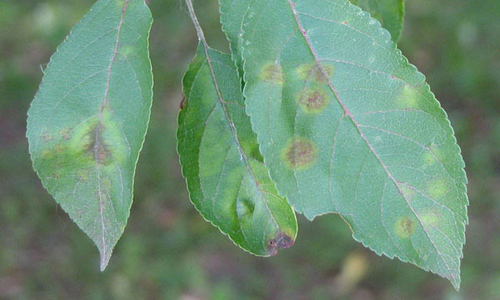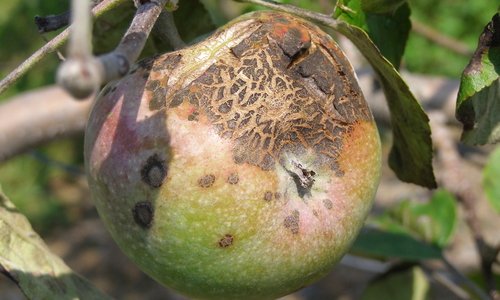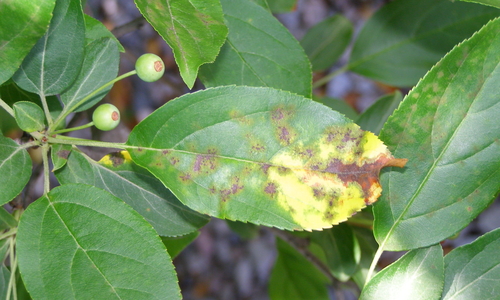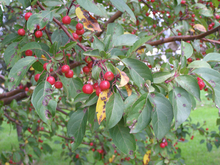Quick facts
- Apple scab is the most common disease of apple and crabapple trees in Minnesota.
- Scab is caused by a fungus that infects both leaves and fruit.
- Scabby fruit are often unfit for eating.
- Infected leaves have olive green to brown spots.
- Leaves with many leaf spots turn yellow and fall off early.
- Leaf loss weakens the tree when it occurs many years in a row.
- Planting disease resistant varieties is the best way to manage scab.
- Fungicides can be used to manage apple scab. Proper timing of sprays is needed for fungicides to control disease.
How to identify apple scab
- Leaf spots are round, olive-green in color and up to ½-inch across.
- Spots are velvet-like with fringed borders.
- As they age, leaf spots turn dark brown to black, get bigger and grow together.
- Leaf spots often form along the leaf veins.
- Leaves with many leaf spots turn yellow and drop by mid-summer.
- Infected fruit have olive-green spots that turn brown and corky with time.
- Fruit that are infected when very young become deformed and cracked as the fruit grows.
How does apple scab survive and spread?
Apple scab is caused by the fungus Venturia inaequalis. It infects crabapples and apples (Malus spp.), mountain ash (Sorbus spp.), pear (Pyrus communis) and Cotoneaster (Cotoneaster spp.).
The apple scab fungus has several host-specific strains that can cause disease on one type of plant but not any other. For example, the strain of V. inaequalis that infects mountain ash will only infect other mountain ash trees and will not infect crabapple trees. Apple and crabapple trees are infected by the same strain of the apple scab fungus because the trees are in the same genus.
- Apple scab is caused by the fungus Venturia inaequalis.
- The apple scab fungus overwinters on fallen diseased leaves.
- In spring, these fungi shoot spores into the air.
- Spores are carried by wind to newly developing leaves, flowers, fruit or green twigs.
- Spores need several hours of moisture on the plant surface in order to start new infections.
- These infections grow into spots that can produce more spores within 9 to 17 days.
- Spores are spread by wind, splashing rain or irrigation throughout the tree canopy or to neighboring trees, starting new infections.
- The infection cycle can repeat many times throughout the growing season whenever leaves remain wet long enough.
- Warm, rainy weather in the spring and summer creates ideal conditions for apple scab.
- Leaves with many leaf spots turn yellow and fall off early. This weakens the tree.
- Several years of early leaf loss can result in decreased growth, reduced bloom and increased susceptibility to winter injury.
- Many ornamental crabapple trees are susceptible to apple scab, so the disease can be spread to your fruit trees from nearby flowering crabs.
How to manage apple scab in apples and crabapples
Planting disease resistant varieties is the best way to prevent apple scab. Many varieties of apple and crabapple trees are resistant or completely immune to apple scab.
Very likely to be infected by apple scab
- Cortland
- Honeygold
- McIntosh
- State Fair
- Zestar!TM
Likely to be infected by apple scab
- Beacon
- Fireside
- Haralson
- Keepsake
- Paul Red
- Sweet Sixteen
- Wealthy
- Chestnut Crab
Resistant to apple scab
- HoneycrispTM
Immune to apple scab
- Dayton
- Freedom
- Liberty
- McShay
- Pixie Crunch
- Pristine
- Redfree
- William’s Pride
The following list highlights crabapple varieties that have shown strong scab resistance and are tolerant of Minnesota's low winter temperatures.
- 'Adams'
- 'Adirondack'
- 'Baskatong'
- 'Bob White'
- 'Candymint'
- Coralburst®
- Christmas Holly™
- 'David'
- 'Donald Wyman'
- Firebird®
- Harvest Gold®
- 'Indian Magic'
- 'Indian Summer'
- 'Jewelberry'
- Lollipop®
- 'Louisa'
- Molten Lava™
- M. floribunda
- M. halliana var. parkmanii
- 'Prairie Maid'
- 'Prairiefire'
- 'Purple Prince'
- Red Jewel™
- 'Robinson'
- 'Royal Beauty'
- 'Tina'
- 'Sargent'
- 'Silver Moon'
- 'Strawberry Parfait'
- Malus x zumi
- 'Calocarpa'
Clean up leaves in fall
Remove fallen leaves in fall to get rid of places where the fungus can survive the winter to re-infect trees the next year. Even with good fall clean up of fallen leaves, spores from nearby apple trees could travel to your property, starting the infection cycle again.
- Rake up and destroy fallen leaves before the first snowfall.
- Infected leaves can be burned, buried or composted.
- Instead of raking, leaves can be chopped with a mulching lawn mower.
- Fall lawn fertilizer applications will help breakdown leaves that have been chopped with a mulching lawn mower.
- In mulched areas, urea can be applied to chopped leaf litter to help with decomposition.
Plant and prune correctly
The apple scab fungus needs moisture on the leaves to start a new infection. A well pruned tree with an open canopy allows air to move through the tree and dry the leaves quickly. This can help reduce the severity of apple scab in a tree. For proper pruning of apples, see Growing apples in the home garden.
- Do not overcrowd plants. Use the mature size of the tree as a spacing guide.
- Prune trees so that the branches are spaced far enough apart to let air move through the branches and dry the leaves quickly.
- Remove upright suckers and water sprouts that have formed along the main trunk or within the canopy.
The type of fungicides that can be used and the timing of the sprays depends on whether you intend to eat fruit from the tree or if the tree is only ornamental.
- Do not use fungicides:
- On apple and crabapple varieties that are resistant or immune to apple scab.
- To manage apple scab in ornamental trees or fruit trees where fruit quality is not a concern (i.e. fruit will be used for cider).
- Fungicides can be used:
- To protect fruit trees from leaf loss and fruit infection, on trees where fruit quality is important (i.e. apples for eating fresh) and the tree has a history of severe apple scab.
- To improve the health of a tree that has lost the majority of its leaves to apple scab over 3 years in a row.
- Good sanitation and cultural control practices should always be used in place of or in addition to fungicides.
Fungicides to protect ornamental crabapples from apple scab
Fungicides do not cure leaf spots but will protect healthy leaves from becoming infected. For ornamental crabapple trees, fungicide sprays must be timed to protect new leaves as they emerge in spring.
- Sprays should start when the first green leaf tips appear in the spring.
- This growth stage is known as "½” green tip". This is when the leaf buds have swollen and begun to open so that about ½” of leaf tissue is visible.
- Repeat sprays until the majority of the flower petals have fallen off the tree.
- Check fungicide labels for the recommended spray interval. Most labels offer a range of days to wait before spraying again, such as "7 - 10 days after spraying, you will need to spray again."
- Use the shorter interval:
- When the weather calls for frequent rain.
- Where scab has been a serious problem in past years.
- Use the longer interval:
- In dry weather with little or no rain.
- Where scab has not been a serious problem in past years.
- In many landscapes, 2 well timed fungicides in spring will protect ornamental crabapples from apple scab.
Do not apply fungicides to a diseased tree
Fungicides only protect healthy trees from becoming infected. Once leaf spots appear in the tree, fungicides will not control the disease.
If your tree is already infected with apple scab this year:
- Do not apply fungicides this year.
- Follow the guidelines above to remove fallen leaves at the end of the growing season and prune to open the canopy in winter.
- Consider apply fungicides the following spring if the tree has lost the majority of its leaves to apple scab for three or more years in a row.
Can I spray my own tree?
Small trees can be treated by a home gardener if all instructions on the fungicide label are read and followed. Contact a certified arborist to apply fungicides to large trees.
Fungicides for ornamental crabapples only
This section applies only to ornamental crabapples, NOT EDIBLE APPLES OR CRABAPPLES.
Fungicide active ingredients to treat apple scab on ornamental crabapples:
- Tebuconazole
- Myclobutanil
- Captan
- Chlorothalonil
- Propiconazole
- Mancozeb
- Sulfur/lime sulfur*
- Neem oil*
- Copper**
*Burning of plant tissue may be observed especially in times of high heat.
**Russeting (rough corky skin) may form on fruit with use of copper products.
Fungicides to protect fruit trees from apple scab
Apples and edible crabapple trees that become severely infected with apple scab have poor quality fruit and reduced health as a result of leaf loss. Fungicides can be used to protect healthy trees from apple scab, but will not cure an infected tree.
When should you start spraying?
- Sprays should start when the first green leaf tips appear in the spring.
- This growth stage is known as "½” green tip". This is when the leaf buds have swollen and begun to open so that about ½” of leaf tissue is visible.
How often should you spray?
Check fungicide labels for the recommended spray interval. Most labels offer a range of days to wait before spraying again, such as "7 - 10 days after spraying, you will need to spray again."
Use the shorter interval:
- When the weather calls for frequent rain.
- Where scab has been a serious problem in past years.
Use the longer interval:
- In dry weather with little or no rain.
- Where scab has not been a serious problem in past years.
When can you stop spraying for scab?
In mid-June, examine the leaves on your trees for scab lesions. Be very thorough, checking upper and lower leaf surfaces, leaves on the interior and exterior of the canopy, leaves close to the ground and those higher in the tree.
If you find no or very few apple scab leaf spots:
- You don’t need to spray fungicides again.
If you find scab leaf spots, or if there are scab infected apple or crabapple trees nearby with scab lesions:
- You should continue to spray.
- The lesions on the leaves will release more scab spores all summer long.
Getting apple scab under control
If scab has been a problem in your apple planting, it may take a year or two to get it under control. You should find in the 2nd or 3rd year that you only need to spray from ½” green tip to mid-June, if you:
- Continue with appropriately timed sprays that cover all leaf and fruit tissue.
- Practice excellent sanitation of fallen leaves.
- And if outside sources of fungal spores are few or distant.
What fungicides should you use?
Materials available to home growers for scab control in edible apples and crabapples include captan, lime-sulfur and powdered or wettable sulfur.
Applications of lime-sulfur closely following captan sprays can damage leaves and flower buds, so use caution when rotating these two materials.
All purpose fruit sprays are not recommended
All-purpose sprays, contain combinations of fungicides, insecticides and sometimes miticides.
- These may only be appropriate for scab sprays just after petal fall, when insecticide sprays may also be necessary and pollinators are absent.
- For most apple scab sprays, only the fungicide portion is needed. The insecticide portion of the spray is unnecessary and can harm beneficial insects.
-
NEVER USE AN ALL-PURPOSE FRUIT SPRAY DURING BLOOM. These sprays kill pollinators, including honeybees, bumblebees, solitary bees and many other beneficial insects, because they include an insecticide.
The name of the plant being treated MUST BE LISTED on the fungicide label or the product cannot be used. Some products are registered for use on ornamental crabapples but are not safe to use on crabapple or apple fruit intended for eating. Always completely read and follow all instructions on the fungicide label.
Reviewed in 2019





